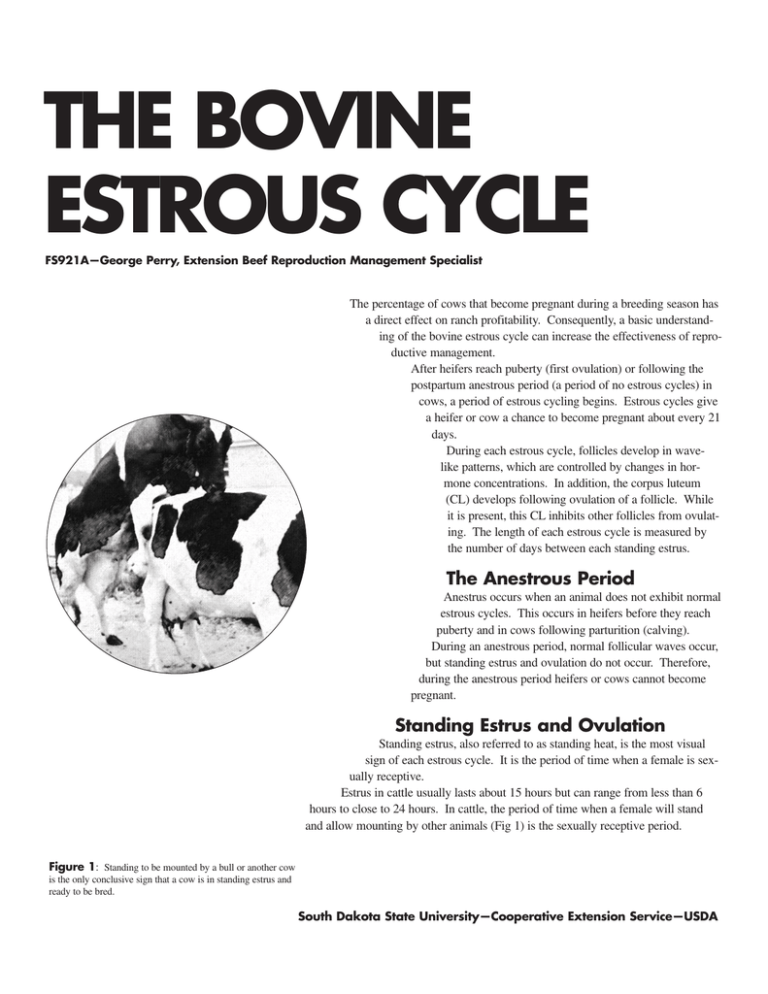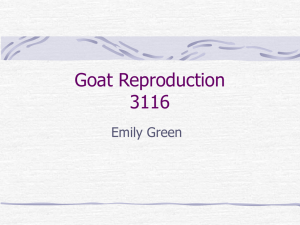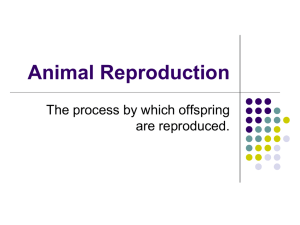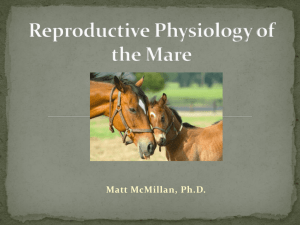The Bovine Estrous Cycle - Applied Reproductive Strategies in Beef
advertisement

THE BOVINE ESTROUS CYCLE FS921A—George Perry, Extension Beef Reproduction Management Specialist The percentage of cows that become pregnant during a breeding season has a direct effect on ranch profitability. Consequently, a basic understanding of the bovine estrous cycle can increase the effectiveness of reproductive management. After heifers reach puberty (first ovulation) or following the postpartum anestrous period (a period of no estrous cycles) in cows, a period of estrous cycling begins. Estrous cycles give a heifer or cow a chance to become pregnant about every 21 days. During each estrous cycle, follicles develop in wavelike patterns, which are controlled by changes in hormone concentrations. In addition, the corpus luteum (CL) develops following ovulation of a follicle. While it is present, this CL inhibits other follicles from ovulating. The length of each estrous cycle is measured by the number of days between each standing estrus. The Anestrous Period Anestrus occurs when an animal does not exhibit normal estrous cycles. This occurs in heifers before they reach puberty and in cows following parturition (calving). During an anestrous period, normal follicular waves occur, but standing estrus and ovulation do not occur. Therefore, during the anestrous period heifers or cows cannot become pregnant. Standing Estrus and Ovulation Standing estrus, also referred to as standing heat, is the most visual sign of each estrous cycle. It is the period of time when a female is sexually receptive. Estrus in cattle usually lasts about 15 hours but can range from less than 6 hours to close to 24 hours. In cattle, the period of time when a female will stand and allow mounting by other animals (Fig 1) is the sexually receptive period. Figure 1: Standing to be mounted by a bull or another cow is the only conclusive sign that a cow is in standing estrus and ready to be bred. South Dakota State University—Cooperative Extension Service—USDA STANDING ESTRUS STANDING ESTRUS A females enters standing estrus gradually. Prior to standing estrus she may appear nervous and restless (for example, walking a fence line in search of a bull or bawling more than usual). Prior to standing to be mounted by a bull or other cows, she will usually try to mount other animals. These signs will progress until standing estrus occurs. Other signs that a cow might be in standing estrus are a roughed up tailhead, a clear mucous discharge from the vagina, and a swollen vulva. However, the only conclusive sign that a cow is in estrus is standing to be mounted by other animals. Following standing estrus, the ovulatory follicle that is present will ovulate, releasing the egg it contains. Rupture of the dominant follicle is referred to as ovulation and occurs between 24 and 32 1 2 3 4 5 6 7 8 9 10 11 12 13 14 15 16 17 18 19 20 21 hours after the onset of standing estrus. Following the release of an egg from an ovulatory follicle the egg will enter the female reproductive tract and be fertilized if the female has been mated. Figure 2: The interval between each standing estrus is about 21 Following each standing estrus, a new estrous cycle will be initiated. In days, but can range from 17 to 24 days. Ovulation occurs between 24 and 32 hours after the initiation of standing estrus (indicated by the a normally cycling animal the interval between each standing estrus should dark circles). be about 21 days (Fig 2), but the range in normal estrous cycle length is from 17 to 24 days. When evaluating reproductive efficiency, it is important to realize that the interval between standing estrus can vary from 17 to 24 days. The Corpus Luteum STANDING ESTRUS STANDING ESTRUS Following ovulation, the different cells that make up the ovulatory follicle change function and become luteal cells that form the corpus luteum (CL). The CL is the main structure on the ovaries during the estrous cycle. The primary purpose of the CL is to produce progesterone, a hormone that regulates several physiological functions. Progesterone prepares the uterus for pregnancy, maintains the pregnancy if fertilization occurs, and also inhibits the cows from showing signs of standing estrus and ovulating. In general, as the CL increases in size during the beginning of the estrous cycle, progesterone production also increases. Elevated concentrations of progesterone can be detected about 5 days after standing estrus. If a cow does not become pregnant, concentrations of progesterone will begin to decrease around day 17 of the estrous cycle. This allows the cow to show standing estrus again around day 21 (Fig 3). 1 2 3 4 5 6 7 8 9 10 11 12 13 14 15 16 17 18 19 20 21 Figure 3: Demonstrates the growth and regression of the CL during the estrous cycle along with changes in concentration of progesterone that occur. Following ovulation, cells from the ovulatory follicle change function and become luteal cells forming the CL (open circles). Concentrations of progesterone increase following the growth of the CL, and decrease with the regression of the CL (dashed line). Follicular Waves In cattle, follicles develop in wave-like patterns, and follicular waves can be detected during most reproductive stages including the prepubertal period in heifers, during estrous cycles, pregnancy (except the last 30 days), and even during the anestrous postpartum period. Following each ovulation, a new follicular wave is initiated. Several follicles are recruited from a pool of small, growing follicles on the ovary and initiate a new follicular wave. Following recruitment of these follicles, a follicle is STANDING ESTRUS STANDING ESTRUS then selected to continue to grow. This selected follicle then becomes the dominant one, inhibiting the growth of any other follicles. In the absence of progesterone, the dominant follicle will become the ovulatory follicle and will ovulate following standing estrus. In the presence of progesterone the dominant follicle will not ovulate, but will undergo atresia (cell death), and a new follicular wave will be initiated. Cattle usually have 2 or 3 follicular waves during each estrous cycle (Fig 4). 1 2 3 4 5 6 7 8 9 10 11 12 13 14 15 16 17 18 19 20 21 Figure 4: Demonstrates three follicular waves occurring during the estrous cycle along with the growth and regression of the CL and the changes in concentration of progesterone. A group of follicles is recruited from the growing pool of follicles on each ovary (group of small circles). A follicle from this recruited group is then selected to continue to grow (medium circles). Finally this follicle becomes the dominant follicle (large circles). The dominant follicle that is present after circulating concentrations of progesterone have decreased will become the ovulatory follicle and ovulate following standing estrus. Several hormones regulate the bovine estrous cycle (Table 1). Changes in the concentrations of these different hormones regulate the recruitment and growth of the follicular waves, the timing of ovulation, and the length of the estrous cycle (Fig 5). STANDING ESTRUS Regulation of follicular waves: Following ovulation, circulating concentrations of Follicle Stimulating Hormone (FSH) increase. This increase in FSH causes the recruitment of a group (cohort) of follicles at the beginning of each follicular wave. After the cohort has been recruited, circulating STANDING ESTRUS concentrations of FSH decrease. Beginning around the time of selection, the continued growth and development of the selected follicle is regulated by Luteinizing Hormone (LH). Luteinizing Hormone also regulates the growth and development of the dominant follicle. While a dominant follicle is present, circulating concentrations of FSH remain low, which inhibits the initiation of a new follicular wave. However, after a dominant follicle ovulates or undergoes atresia, a rise in circulating concentrations of FSH occurs and a new follicular wave is initiated. Hormonal Regulation of the Estrous Cycle 1 2 3 4 5 6 7 8 9 10 11 12 13 14 15 16 17 18 19 20 21 1 2 3 4 5 6 7 8 9 10 11 12 13 14 15 16 17 18 19 20 21 Figure 5: Demonstrates the changes in concentrations of different hormones that regulate the bovine estrous cycle along with the growth and regression of the CL and 3 follicular waves. While a dominant follicle is present, circulating concentrations of FSH (solid line) are low, but following ovulation or atresia of a dominant follicle, circulating concentrations of FSH rise and initiate a new follicular wave. As follicles grow they produce increasing concentrations of estradiol, but when progesterone (dashed line) is present, dominant follicles undergo atresia. When progesterone is not present, concentrations of estradiol (diamond line) increase with follicle size and induce a surge of LH (dashed dotted line, around day 20), which causes ovulation to occur. When no embryo is present, the uterus releases PG (dotted line, around day 16), resulting in luteolysis and allowing standing estrus to occur within a few days. Regulation of estrous cycle length: Maternal recognition of pregnancy occurs around day 15 of the estrous cycle, when the embryo sends a signal to the mother that it is present and developing in the uterus. When a cow does not become pregnant, no signal is received from a developing embryo, and the estrous cycle must be repeated to allow for another opportunity to become pregnant. When maternal recognition of pregnancy does not occur, the uterus releases prostaglandin F2α α (PG) to induce luteolysis (luteolysis means destroying the CL). If luteolysis does not occur, the cow will not be able to return to standing estrus and therefore will not have another opportunity to become pregnant during the breeding season. Regulation of ovulation: As follicles grow they produce increasing amounts of stradiol. During the estrous cycle, when progesterone is present, circulating concentrations of estradiol increase and decrease as follicular waves grow and regress. When progesterone is not present, high concentrations of estradiol cause standing estrus and the behavioral changes associated with standing estrus. High concentrations of estradiol, in the absence of progesterone, stimulate the release of a surge of Gonadotropin Releasing Hormone (GnRH). This surge of GnRH results in a surge of LH, causing ovulation of the ovulatory follicle. Conclusion The bovine estrous cycle is a dynamic process. The growth and development of follicles and the corpus luteum are regulated by changes in the secretion and patterns of different hormones. The ability to understand the estrous cycle will give you a better understanding of reproductive management and the control of the estrous cycle. The ability to control the estrous cycle also can increase the percentage of cows that conceive at the beginning of a breeding season. For Further Reading: Senger, P.L. Pathways to pregnancy and parturition. Current Concepts, Inc. Pullman, WA. Fortune, J.E. 1994. Ovarian follicular growth and development in mammals. Biology of Reproduction 50:225-232. Adams, G.P. 1999. Comparative patterns of follicular development and selection in ruminants. Journal of Reproduction and Fertility. Supplement 54:17-32. This publication is found on the web at: http://agbiopubs.sdstate.edu/articles/FS921A.pdf Issued in furtherance of Cooperative Extension work, Acts of May 8 and June 30, 1914, in cooperation with the USDA. Larry Tidemann, director of CES, associate dean, College of Agriculture & Biological Sciences, South Dakota State University, Brookings. South Dakota State University is an Affirmative Action/Equal Opportunity Employer and offers all benefits, services, education, and employment without regard for race, color, creed, religion, national origin, ancestry, citizenship, age, gender, sexual orientation, disability, or Vietnam Era veteran status. FS921A: 1,000 copies printed at_each. January 2004.


